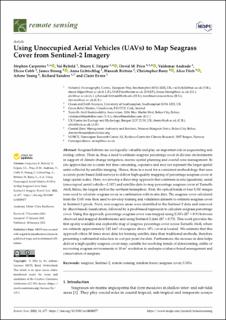| dc.description.abstract | Seagrass habitats are ecologically valuable and play an important role in sequestering and storing carbon. There is, thus, a need to estimate seagrass percentage cover in diverse environments in support of climate change mitigation, marine spatial planning and coastal zone management. In situ approaches are accurate but time-consuming, expensive and may not represent the larger spatial units collected by satellite imaging. Hence, there is a need for a consistent methodology that uses accurate point-based field surveys to deliver high-quality mapping of percentage seagrass cover at large spatial scales. Here, we develop a three-step approach that combines in situ (quadrats), aerial (unoccupied aerial vehicle—UAV) and satellite data to map percentage seagrass cover at Turneffe Atoll, Belize, the largest atoll in the northern hemisphere. First, the optical bands of four UAV images were used to calculate seagrass cover, in combination with in situ data. The seagrass cover calculated from the UAV was then used to develop training and validation datasets to estimate seagrass cover in Sentinel-2 pixels. Next, non-seagrass areas were identified in the Sentinel-2 data and removed by object-based classification, followed by a pixel-based regression to calculate seagrass percentage cover. Using this approach, percentage seagrass cover was mapped using UAVs (R2 = 0.91 between observed and mapped distributions) and using Sentinel-2 data (R2 = 0.73). This work provides the first openly available and explorable map of seagrass percentage cover across Turneffe Atoll, where we estimate approximately 242 km2 of seagrass above 10% cover is located. We estimate that this approach offers 30 times more data for training satellite data than traditional methods, therefore presenting a substantial reduction in cost-per-point for data. Furthermore, the increase in data helps deliver a high-quality seagrass cover map, suitable for resolving trends of deteriorating, stable or recovering seagrass environments at 10 m2 resolution to underpin evidence-based management and conservation of seagrass. | en_US |

